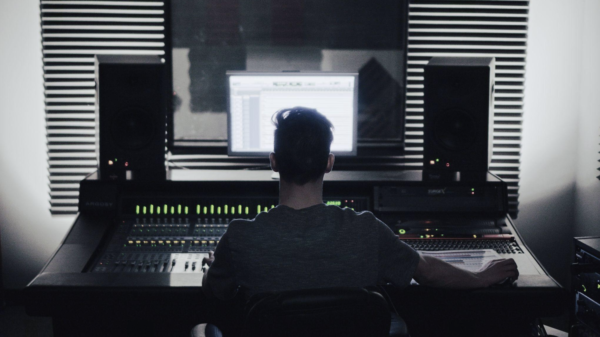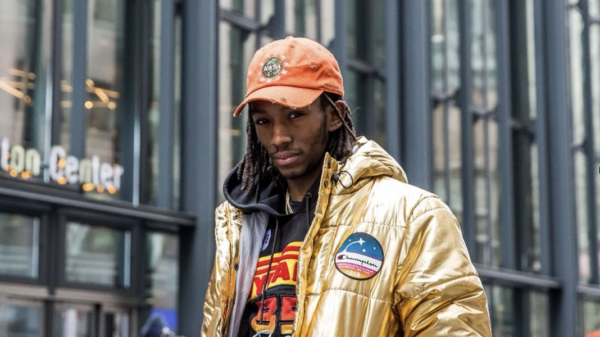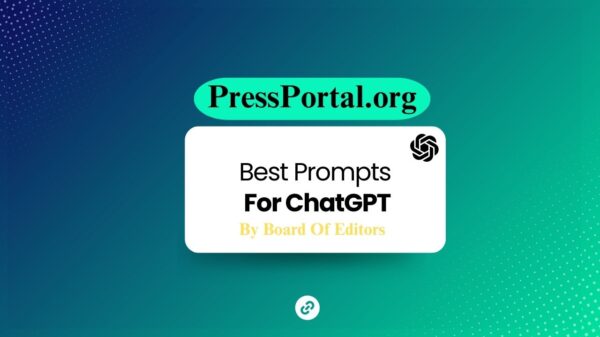On Sept. 19, 1969, David Crosby, Stephen Stills, and Graham Nash walked onstage at the Fillmore East in New York City, took a seat on three stools, and launched into “Suite: Judy Blue Eyes” without any introduction. It was just four weeks after they played their first ever show at the Auditorium Theater in Chicago — followed a couple days later at a little festival called Woodstock — and they were already one of the most popular groups in America. New bandmate Neil Young remained backstage, letting the original trio play a few songs on their own before coming out, turning CSN into CSNY.
“The Fillmore was absolutely silent,” read a review in a local paper. “When ‘Suite: Judy Blue Eyes’ was over, the audience applauded and cheered wildly, and gave the trio a standing ovation. How could a Byrd, a Buffalo Springfield, and a Holly dare come out on stage at the acid-freak rock Fillmore and play acoustic music and get away with it?”
They got away with it because the “acid-freak rock scene” was coming to an abrupt end, and a new generation of singer-songwriters like Joni Mitchell, Carole King, Cat Stevens, James Taylor, Carly Simon, and the four members of CSNY were arriving to fill the void. In less than two years, the Fillmore East itself would close, and CSNY would implode due to personality conflicts, drugs, and the demands of their solo careers.
Before all that happened, they were just four friends performing their songs at the Fillmore. They played an early show and a late show on both Sept. 19 and 20, 1969, and all four gigs were professionally recorded. The tapes sat in the vault these past 55 years, but fans will finally get to hear them on Oct. 25 when Live at Fillmore East, 1969 hits shelves.
To talk about the historic shows, the joys and sorrows of that crazy time period, his ongoing solo tour, and coming to peace with Crosby’s death, we chatted with Nash via Zoom from his hotel room in Evanston, Illinois.
How did this Fillmore package come together?
It was mainly put together by Stephen and Neil in Los Angeles, and obviously they kept me in touch with everything that they were doing since I live in New York City now. And to me, one of the great things about it was just how much we loved each other at this point. I loved the music. And of course, when we added Neil and began to rock out…I think Neil said it was one of the best “Down by the River” performances that he’d ever done.
Editor’s picks
What stands out in your mind about these Fillmore shows?
I think just how much we really dug being together and dug playing the music. One on the nights, I think we’d already done two or three encores, and the crowd was going just crazy. Bill Graham came up to the door and he knocked on the dressing room door. He said, “You got to come down and play another one.” And we said, “Wait a second, Bill. We’ve already played three.” So he starts to put $100 bills under the door. And when he got to $800, Neil said, “Okay, okay, okay. I’ll just throw them out into the audience.” And I said, “Neil, this is New York. If you start throwing $100 bills into the audience, they will kill themselves trying to get to them. You can’t do that.”
I was reading reviews of your early shows. They all talk about how you were going against the grain of the harder music of the era.
And we knew that. Even when we did the first Crosby, Stills & Nash record, it was a gentle and acoustic thing. And we knew that in the age of Hendrix and Led Zeppelin, it would slip through all that and make it to the top, which of course it did.
You played The Tom Jones Show right before the Fillmore, and he sang “Long Time Gone” with you guys. What’s your memory of that day?
It was pretty surreal, but it worked. Tom Jones is a great singer. We know that he makes a different kind of music than us, but he held his own. He sang the lead there. He was great. I was on organ, and David and Stephen and Neil were playing with him. It was a pretty interesting piece of video.
Related
You first played “Our House” at the Fillmore. Do you remember that moment?
I do. I thought it was a pretty simple song. Most of my songs are done from ordinary moments, something I hear, something I see, somebody says. And “Our House” was a perfect example. I knew it was a simple song, but I also knew that because of my experiences of making records with the Hollies, that if we really cut it well, it would be a hit.
Was Joni Mitchell in the audience when you first sang it?
Yeah. She was sitting in the third row.
What was that moment like for you?
I was on cloud nine. Joni and I were a couple. About a week ago, we played in Ottawa in Canada, and that was the first place I’d ever met Joni. So I was thinking about her a lot that night.
It’s interesting to look at where Neil’s career was before he joined CSN. His first two albums didn’t make a huge impact, great as they were, and he was playing tiny clubs. Some of the posters didn’t even get his name right. When he opened for Deep Purple, they billed him as “Mell Young.”
Yeah. Joining CSN was probably the best thing that Neil ever did.
After less than a year with you guys, he was headlining the Fillmore on his own.
That’s right. Once again, the power of music.
How do you feel when you listen back to those tapes from the Fillmore?
Happiness at the magic that we could create. And we were really our normal selves on stage, joking and laughing. And it was amazing. It was a magical time for us.
The Fillmore shows were the final ones you played before Croz’s girlfriend, Christine Hinton, died in a car crash. In so many ways, that sent him spiraling, and really impacted the group going forward.
Yeah. That was a very sad day. We were sitting by the pool in Nevada, in California, which is where David and Christine had rented, when we got the news. And in the garden is where we shot the cover of Deja Vu. And that dog, nobody knows who that dog was, it just ran into the picture, and it was just perfect. But that just shows what was going on with us. It was magical really.
How does the Fillmore album compare to the live album 4 Way Street, which was cut a year later?
Well, I finished my relationship with Joni, even though I send her flowers every year on her birthday, and I’m still great friends with her. Christine had been killed, and Stephen and Judy Collins had broken up. So it was a very different time. It was a lot darker. And it was amazing to think that only a year had passed. We were very different people. We were a little depressed, getting too much into drugs. It was a very different time.
It was also the year of Altamont, Kent State, the Manson murders. A darkness descended on everything so quickly.
And don’t forget, Nixon was crazy with the secret bombing of Cambodia, which is why the four students at Kent State had been killed. It all turned dark. It really did. It was no longer the summer of love with sunshine and flowers. It was a much darker time, even in America.
You packed so much music into that one year though.
We did. And we all had lots of music to make. That’s why David did If I Could Only Remember My Name, and Stephen did Stephen Stills and joined Manassas, and I did Songs for Beginners. It was a great time for us all.
Why did it take so many years to get this Fillmore album out?
We’ve all done a lot of recording. There are a lot of tapes still existing of us that have never been seen the light of day. And when David passed, we dedicated the entire album to him, because he really was the heartbeat of this band, and his passing brought a halt to us all making music together. I don’t think that me and Stephen and Neil will ever play together again.
Why?
There’s no heart there. David was the center of it all, as crazy as he was. And my God, he was crazy. But he was the heart of this band. And that’s why I think that if Stephen and Neil and I ever played together, people would be missing Crosby. We would be missing Crosby. It just would be a much colder scene.
You play his voice onstage every night at your solo concerts. What’s it like for you emotionally to hear his voice come out of the speakers?
It’s very emotional for me. During the time that David and I were not talking to each other, he refused to let me play “Critical Mass,” which was tied to my song “Wind on the Water” on the record [Wind on the Water] that we made. And that was very sad for me because regardless of what we were arguing about, you can’t mess around with music like that. So when I do play “Critical Mass” and talk about David’s passing, it’s very emotional for me.
I really miss him. I miss him more every day because life is choices, and I only choose to remember the good times that David and I had, the good music that we made together. When I try and think about the bad things that happened, I don’t want to do that. I made the choice to only remember the good stuff.
You guys were reconnecting at the very end. Had he lived, I really think there would have been a full reconciliation.
Yes, there’s no doubt about it. We were emailing, and he voicemailed me, and then I set up a FaceTime meeting with him because I wanted us to be able to look at each other when we were talking. And then he got Covid. I wasn’t feeling very well, and we missed that date. And a couple of days later he passed.
It must give you some comfort that you were at least communicating at the end.
[Softly] Very much so, yes. Very, very much so.
Getting back to the Fillmore, there’s high quality video of the 1970 Fillmore run. Might you ever release all of that?
We filmed a lot of that. I believe that Neil has the footage. And I think that’s probably the next project that we’ll do.
What else do you hope to release from the vault?
There’s an album that I’ve been working on for a few years. It’s me and David singing with Stephen Stills and with Kenny Loggins and with Carole King and with John Mayer and with James Taylor. It’s a collection of the great music that we made singing the backups for all those great records like “Mexico” and “Love the One You’re With,” and “You Got a Friend,” and “All the Pretty Little Ponies” with Kenny Loggins. It’s beautiful stuff. We have 26 pieces to choose from.
You do a ton of shows these days. What drives you to work this hard at age 82?
I keep writing and I keep experiencing what the power of music is. I’m judging what the audience is going through. We are doing tremendous business, really. We’re selling out almost every single night. And it’s been incredible. And with [drummer] Adam Minkoff and [guitarist] Zach Djanikian and [keyboardist] Todd Caldwell…they’re much younger than me, quite frankly they’re kicking me in the ass every night. I have to bring my A game every single night to be on top of what they’re doing. And we’re having a great deal of fun doing it. They are brilliant musicians, and I really appreciate them.
Stills is essentially retired, and Young plays very little of the CSNY catalog when he tours. You’re the only one out there playing this music. Do you feel an obligation to keep it alive?
I don’t feel an obligation. I feel great joy in playing that kind of music. And I want my audience to know two things. One, that I want to be there making music for them. I’m not going to phone it in. I’m not going to do it half-assed. Secondly, I’m going to sing the same songs that I’ve done a million times with the same passion I had when I wrote them. And I believe that I owe that to my audience.
You have a stronger voice than many singers years younger than you. What’s the secret to keeping it?
I don’t have a secret. I don’t have a vocal coach. I don’t have lessons. I rarely warm up before a show. I just naturally sing and thank God I can still do it.
Fans would love to see you and Allan Clarke of the Hollies play onstage together one day. Do you think that’s possible?
I think it’s possible. Allan is a little wary. I think he’s a little envious of my success. We did try and do a couple of things with “Buddy’s Back” [from my 2023 LP Now] that I wrote about our love for Buddy Holly. On that record, I sing the lead and he joins me in the chorus. And on his record [2023’s I’ll Never Forget], he sings the lead, and I join him on the chorus. But our friendship is really blossoming, and I’m very appreciative.
I had the chance to see Neil and Stephen play together at Painted Turtle just a few days after I saw you and Judy Collins at Carnegie Hall.
How was it?
They were great. It was amazing to see them play those songs together again.
Stephen is still a fabulous guitar player.
There was this moment where they locked in together during “Bluebird” that was just magical.
That’s one of the reasons why Neil joined the band. When we were talking about getting Neil, I said, “Wait a second. I don’t know Neil Young. I’ve never met him. I know he is a good songwriter and a decent singer, but I have to talk to him. I want to be his friend. Can he be my partner?” And at the end of breakfast, he looked to me and said, “You know something? You need me in this band.” And I said, “Why?” He said, “Have you ever heard me and Stephen play guitar together?” And when you just said that, it took me back to the many, many times I’ve stood onstage and been a witness to their conversations with guitars.
It’s great they’re still friends after everything they’ve been through.
Yes. And it’s obvious how much they love each other.
Are you working on new songs at the moment?
I’m always writing, particularly in today’s crazy political place.
Trending
Are you worried about the election?
Yes. People keep telling me how close it is and how they’re tied. I just have tremendous hope that Kamala will be able to pull this off because I think another Trump presidency will be just awful for not only America, but for the rest of the world. I have no idea what hold this man Trump has on Republicans. It’s almost like a “If you don’t vote for me, I’ll kill your entire family” kind of vibe. Why does he have such an incredible hold on everybody?
I wish I had answer to that. But to wrap on music, do you think you’ll be like Pete Seeger and still playing shows in your 90s?
Why not? I saw [Spanish guitarist Andrés] Segovia when he was 92, and he killed me. He was so good. It was the same thing with the Mills Brothers. Why not?



























